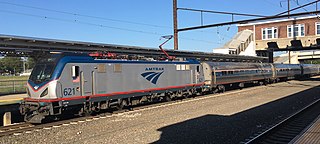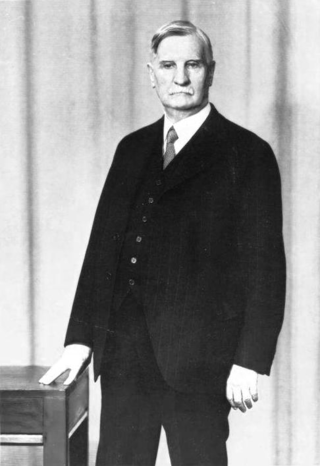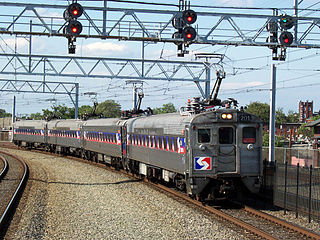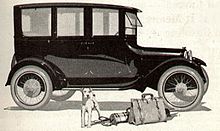
The Metroliners were extra-fare high-speed trains between Washington, D.C., and New York City which operated from 1969 to 2006. They were briefly first operated by Penn Central Transportation, then by Amtrak for 35 years.

The Keystone Service is a 195 mile regional passenger train service from Amtrak between the Harrisburg Transportation Center in Harrisburg, Pennsylvania, and 30th Street Station in Philadelphia, running along the Philadelphia to Harrisburg Main Line. Most trains continue along the Northeast Corridor (NEC) to Penn Station in New York City.

A dome car is a type of railway passenger car that has a glass dome on the top of the car where passengers can ride and see in all directions around the train. It also can include features of a coach, lounge car, dining car, sleeping car or observation. Beginning in 1945, dome cars were primarily used in the United States and Canada, though a small number were constructed in Europe for Trans Europ Express service.

The Philadelphia and Western Railroad was a high-speed, third rail-equipped, commuter-hauling interurban electric railroad operating in the western suburbs of Philadelphia, Pennsylvania. It is now SEPTA's Norristown High Speed Line, though the Strafford spur has been abandoned. Part of the abandoned line within Radnor Township is now the Radnor Trail, a multi-use path or rail trail.

The SEPTA Regional Rail system is a commuter rail network owned by SEPTA and serving the Philadelphia metropolitan area. The system has 13 branches and more than 150 active stations in Philadelphia, Pennsylvania, its suburbs and satellite towns and cities. It is the sixth-busiest commuter railroad in the United States, and the busiest outside of the New York, Chicago, and Boston metropolitan areas. In 2016, the Regional Rail system had an average of 132,000 daily riders and 118,800 daily riders as of 2019.

The Budd Rail Diesel Car (RDC), also known as the Budd car or Buddliner, is a self-propelled diesel multiple unit (DMU) railcar. Between 1949 and 1962, 398 RDCs were built by the Budd Company of Philadelphia, Pennsylvania, United States. The cars were primarily adopted for passenger service in rural areas with low traffic density or in short-haul commuter service, and were less expensive to operate in this context than a traditional diesel locomotive-drawn train with coaches. The cars could be used singly or coupled together in train sets and controlled from the cab of the front unit. The RDC was one of the few DMU trains to achieve commercial success in North America. RDC trains were an early example of self-contained diesel multiple unit trains, an arrangement now in common use by railways all over the world.

The Pioneer Zephyr is a diesel-powered trainset built by the Budd Company in 1934 for the Chicago, Burlington & Quincy Railroad (CB&Q), commonly known as the Burlington Route. The trainset was the second internal combustion-powered streamliner built for mainline service in the United States, the first such train powered by a diesel engine, and the first to enter revenue service.

Edward Gowen Budd was an American inventor and businessman.

The Denver Zephyr was a streamlined passenger train operated by the Chicago, Burlington and Quincy Railroad between Chicago, Illinois, and Denver, Colorado. In peak years it ran to Colorado Springs. It operated from 1936 to 1973. The Denver Zephyr continued operating after the Burlington Northern Railroad merger in 1970. BN conveyed the train to Amtrak in 1971; Amtrak merged it with the Denver–Oakland City of San Francisco to form the San Francisco Zephyr and dropped the "Denver" name in 1973.

Amfleet is a fleet of single-level intercity railroad passenger cars built by the Budd Company for American company Amtrak in the late 1970s and early 1980s. Budd based the Amfleet design on its earlier Metroliner electric multiple unit. An initial order for 57 cars in 1973 to supplement the Metroliners on the Northeast Corridor grew to two orders totaling 642 cars, sufficient to reequip all the services on the Northeast Corridor and many other routes around the United States. The first 492 cars, known as Amfleet I and completed between 1975 and 1977, were designed for short-distance service. A second order of 150 cars, known as Amfleet II and completed between 1980 and 1983, were designed for long-distance service. They were the last intercity passenger cars built by Budd.

The Budd SPV-2000 is a self-propelled diesel multiple unit railcar built by the Budd Company between 1978 and 1981 for use on North American commuter railroads. The design was a successor to Budd's popular Rail Diesel Car (RDC) but based on the body of the Amfleet passenger car. It did not prove a success: Budd built 31 cars and they proved mechanically unreliable.

The MS Multi-section was a series of New York City Subway cars. They were built in prototype form in 1934 with production models built in 1936. Built by the Budd, Pullman, and St. Louis car companies, they were called "Multis" for short. They were so named because each car was an articulated car made of five sections; though the MS Multi-section fleet's lengths differed, their average length was 170 ft (52 m).

The Pioneer III railcar was a short/medium-distance coach designed and built by the Budd Company in 1956 with an emphasis on weight savings. A single prototype was built, but declines in rail passenger traffic resulted in a lack of orders so Budd re-designed the concept as an electric multiple unit (m.u.). Six of the EMU coach design were purchased by the Pennsylvania Railroad with the intention of using them as a high-speed self-contained coach that could be used for long-distance commuter or short-distance intercity travel in the Northeast U.S. The 6 production Pioneer III units were the first all-stainless-steel-bodied EMU railcar built in North America and, at 90,000 pounds (41,000 kg), the lightest.

The Crusader was a 5 car stainless steel streamlined express train that ran on a 90.3-mile (145.3 km) route from Philadelphia's Reading Terminal to Jersey City's Communipaw Terminal, with a ferry connection to Lower Manhattan at Liberty Street. The Reading Railroad provided this service in partnership with the Central Railroad of New Jersey (CNJ), in which it was the majority owner of capital stock. Trains including the Crusader ran on Reading Railroad tracks from Reading Terminal in Philadelphia to Bound Brook, NJ, where they continued on CNJ tracks to Communipaw Terminal in Jersey City. Passengers then left the train and walked aboard the ferry or boarded busses that loaded onto the ferry. Introduced in 1937, the Crusader service declined during the 1960s, and the name was ultimately dropped in 1981.

The Budd Metroliner was a class of American electric multiple unit (EMU) railcar designed for first-class, high-speed service between New York City and Washington, D.C., on the Northeast Corridor. They were designed for operation up to 150 miles per hour (240 km/h): what would have been the first high speed rail service in the Western Hemisphere. Although 164 mph (264 km/h) was reached during test runs, track conditions and electrical issues limited top speeds to 120 mph (190 km/h) in revenue service. The single-ended units were designed to be arranged in two-car sets, which were in turn coupled into four to eight-car trains.
The streamliner cars are a class of streamlined passenger railroad cars built from the 1930s through the 1960s for long distance passenger train services in North America.

Silverliner is the name given to a series of electric multiple unit (EMU) railcars in commuter rail service in the Philadelphia area since 1958. As of the introduction of the Silverliner V in 2009–2010, there have been 5 generations of Silverliner cars, identified by the Roman numerals I through V placed after the name Silverliner. The Silverliner name came from the classes' shiny stainless steel body shell, which contrasted with the painted and frequently rusting carbon steel railcars used by the Pennsylvania and Reading Railroads between 1915 and 1936. Applied to the first large production order in 1963, the cars made such an impression that the name has since been applied to all subsequent MU classes purchased by SEPTA for the Regional Rail services.

The Budd Silverliner was a model of electric multiple unit railcar designed and built by the Budd Company with 59 examples being delivered starting in 1963. Fifty-five of the cars were purchased for the Reading and Pennsylvania Railroads with public funds for use in Philadelphia, Pennsylvania, area commuter rail service with the remaining 4 cars being purchased by USDOT for use in high-speed rail experiments in 1965. Based on a series of 6 prototype Pioneer III cars built in 1958, the Silverliners represented the first production order of "modern" commuter MU equipment purchased by either railroad and earned their name from their unpainted stainless steel construction which contrasted with the painted carbon steel bodies of the pre-war MU fleets. The cars became a fixture of SEPTA Regional Rail service providing the name to their entire series of EMU railcars before finally being retired in 2012 after 49 years in service.

The Budd–Michelin rubber-tired rail cars were built by the Budd Company in the United States between 1931 and 1933 using French firm Michelin's "Micheline" rail car design. Michelin built its first rail car in 1929, and by 1932 had built a fleet of nine cars that all featured innovative and distinctive pneumatic tires. In September 1931, an agreement signed between the two companies allowed Budd to use the new rubber rail tires on its shot-welded, stainless-steel carbodies, and at the same time allowed Michelin to expand into the American market.

































